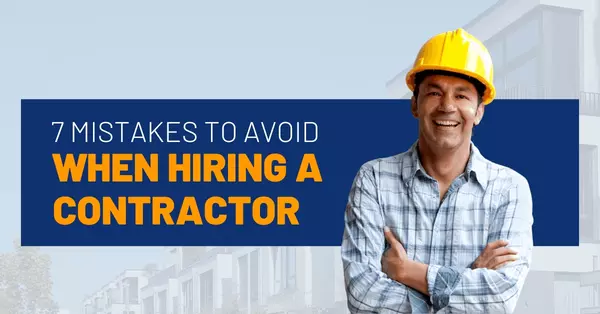
Multigenerational Home Buying: How to Find a Home That Fits Your Whole Family
For many homebuyers, multigenerational living used to be considered an option of last resort: it was a route families took only when they needed to ride out a financial storm or care for ailing family members. But that mindset is on the decline: A growing number of families now say that they are embracing multigenerational living and moving in together by choice. In fact, research by the National Association of Realtors (NAR) found that the share of multigenerational home buyers rose to 14% in 2022––close to an all-time high.1 Buyers cite a multitude of reasons for choosing a multigenerational home, including saving money on living expenses, pooling resources, taking care of very young or aging relatives, and spending more time with family. "Multi-generational home buying is a way for families to care for one another, support one another, and often buy a home that may have been previously out of reach," writes Deputy Chief Economist Jessica Lautz in a blog post about the trend.1 Living with extended family has become especially popular in recent years as younger generations face higher home costs and seniors embrace aging in place. According to Pew Research, the number of Americans living in a home with at least two generations of adults has more than quadrupled since the 1970s.2 For many families, the benefits are substantial. Research shows that people who live in multigenerational homes are healthier and tend to live longer. They also enjoy more financial security. Plus, research by Pew found that people who live with relatives are more likely than not to say that it has been a positive experience.2,3 That's not to say that multigenerational living is easy: It can also be stressful––especially if you choose a home that isn't suited for a larger family. The key to making it work is to pick a home that can accommodate young and old alike without requiring you to sacrifice comfort or privacy.2,4 Here's a closer look at multigenerational living, along with tips for finding a home that's suitable for a diverse group. WHAT TO CONSIDER BEFORE SHOPPING FOR A MULTIGENERATIONAL HOME Before starting your house hunt, take the time to discuss your house plans as a family so that you're all on the same page. Have you hashed out what you're looking for in a new home? Can you agree on potential compromises? Are there any unaddressed concerns about the move? You may also find it helpful to articulate your "why" for buying a multigenerational home and how each of you might benefit. For some families, multigenerational living is all about caring for relatives and sharing responsibilities. But for others, the goal is to pool resources so that you can purchase a more desirable property or cut down on expenses, like childcare or senior living. For homeowner Jian Huang, she initially bought a multigenerational home to help her aging mother. But she says the purchase also helped her family save a lot of money on expenses––as much as $25,000 to $40,000 a year. “It makes so much sense financially and emotionally that we would not have it any other way,” commented Huang to Apartment Therapy.5 In addition to talking over your short-term wants and needs, you'll also want to weigh long-term issues that could crop up in the future, like accessibility or money concerns. For example, if some family members are nearing retirement, accessibility issues (such as extra-steep stairs or a narrow hallway) could become a problem over time. Similarly, a more luxurious home with extra amenities like a pool may appeal to buyers who have gathered a lot of cash upfront, but it may also require a bigger long-term budget for maintenance and supplies. If you haven't had these discussions yet, set a date in your calendar so that you can talk it over as a group. I can help by interviewing family members individually and advising you on what you can realistically find in today's housing market. WHAT TO LOOK FOR IN A MULTIGENERATIONAL HOME Once you've settled on what you want and need from a new home, your next step should be to jointly draft a budget so that you'll know what you can afford. To ensure that no one in your family gets accidentally overextended, think holistically when planning your new housing budget and determine what you would need to buy the home––and maintain it. In addition to budget, you'll also want to consider a home's size and what kind of layout you might need. In general, homes that offer ample space for solitude and privacy are thought to be more practical for multigenerational living––especially if there will also be young children.4 However, the ideal layout for your family and the amount of square footage you'll need to be happy long-term will also depend, in part, on family members' personalities. Some people don't mind sharing a bathroom or having bedrooms situated close to one another. But others may find that they need something more separate to relax. Different housing options to consider include: A large home with plenty of rooms and at least one or more ensuite bathrooms. A home with an accessory dwelling unit (ADU), such as a basement apartment. A multifamily unit, such as a duplex. For home buyers looking to age in place, a home that offers a separate ground-floor unit, such as a backyard ADU, could be the most comfortable (and the most practical) option, says author Sheri Koones. “It’s a way for many older people to avoid having to go into an expensive assisted living or other facility as they age,” said Koones in an interview with Realtor Magazine.6 Another possibility to consider would be a home you could add onto or retrofit into multiple units. However, building a brand-new accessory unit or renovating an existing space can be pricey. When visiting a property, I'll help you weigh potential costs and estimate whether it's a good investment. I can also connect you with a trusted contractor who specializes in renovations. HOW TO BUY A MULTIGENERATIONAL HOME Buying a home with family can be complicated––especially if you plan to jointly apply for a mortgage. However, depending on your financial resources, you may be surprised to find that it's sometimes easier to qualify for certain mortgages as a group than if you tried to go it alone.7 Talk it over with a mortgage lender or broker and ask for advice on what's best for your situation. I'd be happy to connect you with a professional who understands the nuances of co-buying. Technically, there's no limit to the number of co-borrowers you can have, but some lenders may be more lenient with their lending requirements than others. For example, most conventional lenders will only work with a maximum of four borrowers for a single loan. If you want to buy a home with a larger number of co-borrowers, you may have to look to an alternative lender.7 Your credit will also be an important factor in determining your mortgage qualifications and what you can buy, so have everyone check it as soon as possible. Pulling your credit reports and scores will not only tell you where you stand. It will also alert you to correctable issues with your credit, such as mistakes on your credit reports or too much debt on your cards.8 As you discuss your homebuying budget and strategy, jointly consider the following: Who will be on the mortgage? What about the title? Would including everyone on the mortgage be beneficial for your mortgage rate? For those who don't qualify for the mortgage or have a lower credit score, can you make other arrangements so that they can still financially contribute? Next, consider potential tax and estate planning implications of your home purchase and what might happen if some family members later decide to drop out of the arrangement.9 To ensure you make an informed decision, it's best to speak with a licensed professional. Ask me for a referral to a legal professional or an accountant who can advise you. BOTTOM LINE Multigenerational home buying has grown more popular for a reason: it's a great way to combine resources and buy a supportive home for more than just your immediate family. It can also be a smart lifestyle choice, helping reduce loneliness and promote health and well-being.10 If you're wondering whether multigenerational living is right for you, call us for a consultation. I'd be happy to walk you through potential options and help you envision your own full house. The above references an opinion and is for informational purposes only. It is not intended to be financial, legal, or tax advice. Consult the appropriate professionals for advice regarding your individual needs. Sources: National Association of Realtors -https://www.nar.realtor/blogs/economists-outlook/all-in-the-family-multi-generational-home-buying Pew Research Center -https://www.pewresearch.org/social-trends/2022/03/24/financial-issues-top-the-list-of-reasons-u-s-adults-live-in-multigenerational-homes/ SSM - Population Health -https://www.ncbi.nlm.nih.gov/pmc/articles/PMC5769098/ Better Homes and Gardens -https://www.bhg.com/what-to-look-for-in-a-multigenerational-home-8409277 Apartment Therapy -https://www.apartmenttherapy.com/multigenerational-homes-37412085 Realtor Magazine -https://www.nar.realtor/magazine/real-estate-news/home-and-design/all-under-one-roof-trends-in-multigenerational-living Bankrate -https://www.bankrate.com/mortgages/how-many-names-can-be-on-a-mortgage/ Experian -https://www.experian.com/blogs/ask-experian/what-credit-score-do-i-need-to-buy-a-house/ Kiplinger -https://www.kiplinger.com/retirement/estate-planning-for-multigenerational-living-arrangements Institute for Family Studies -https://ifstudies.org/blog/multigenerational-living-is-it-a-solution-for-our-aging-population

Stage to Sell: 7 Proven Steps to Attract Buyers and Boost Offers
Selling your home quickly and at the right price takes more than just listing it online. To draw in potential buyers and secure top offers, your home needs to stand out. That’s where home staging comes in. By strategically preparing your home—through redecorating, repairing, and making it look its best—you can make a lasting impression and significantly increase its appeal. The numbers speak for themselves: according to the National Association of Realtors, 81% of buyers’ agents report that staging makes it easier for potential buyers to envision themselves living in a home. Moreover, 44% of buyers’ and sellers’ agents say that staging can increase a home’s sales price, and 48% of sellers' agents agree it shortens the time a house spends on the market.1 You can choose to stage your home yourself with advice from your real estate agent or work with a professional stager. Whichever route you take, here are seven essential strategies to transform your home into a buyer’s dream. Step #1: Declutter and Depersonalize The first step in staging is to declutter and depersonalize your home. A recent survey of real estate agents found that this simple step can increase your home’s sale price by 3-5%.2 Ideally, you want to create a clean, neutral canvas where potential buyers can imagine their own lives. Remember that staging isn’t interior design—the goal isn’t to add personal, homey touches but to take them away.3 While you may love having plenty of comfy furniture, family photos, and unique knick-knacks, these items can distract potential sellers and make your home feel smaller.4 Be especially mindful to remove children’s toys and pet items. The task can feel overwhelming, but consider it a head start on packing for your move — and an opportunity to clear out things you no longer need. If you have a lot of belongings, renting a storage unit might be a smart way to keep things tidy while your home is on the market. Step # 2: Deep Clean and Repair A sparkling clean home leaves a fantastic first impression. Deep clean every room, paying special attention to areas that are often overlooked, like baseboards, windows, and appliances. Even minor smudges, scrapes, or signs of pet hair can put off some buyers. Your goal? Make it look like no one has ever lived there!5 Minor repairs are equally important. Fix slight imperfections like chipped paint, regrouting tiles, and replacing worn hardware. These easy cosmetic updates make a big difference in how buyers perceive your home’s value. For example, refinishing hardwood floors can offer a 147% return on investment.6 Need help getting your home spic-and-span? Let me recommend a professional who can help. Step #3: Pick Up a Paintbrush While buyers may repaint after they move in, the color and condition of your walls still have a big impact on their impression of the home as a whole. Neutral tones like beiges and off-whites appeal to the widest range of buyers—and to the friends and relatives who are also weighing on purchasing decisions.7 If your home features bold colors or striking wallpaper, consider a repaint before you list. When choosing paint colors, make sure to think about how they’ll appear in listing photos and videos. Light, neutral shades can make rooms look brighter and more spacious. Repainting is especially important in high-traffic areas like the kitchen. Painting outdated cabinets in white or a soft gray can also modernize your space.8 Step #4: Enhance Curb Appeal First impressions matter, and your home's exterior is the first thing buyers will see. That’s why 98% of agents believe that curb appeal is crucial to attracting a buyer.9 Boost your home’s curb appeal by power-washing the exterior and touching up your deck’s varnish.5 You might also consider repainting your front door. Research shows that a freshly painted front door in a classic shade like black or terracotta can increase offers by thousands of dollars.10 And don’t forget landscaping! Keep your lawn tidy, remove dead or dying plants, and consider adding seasonal flowers. Even standard lawn service can lead to a 217% return on investment.9 If you need assistance, I'm happy to offer a referral to landscapers in our area. Step #5: Stage Key Rooms When staging, concentrate on the rooms that matter most to buyers: the living room, primary bedroom, and kitchen. These spaces have the greatest influence on a buyer’s decision.1 If you’re working with a professional stager, they may bring in furniture and decor.3 If not, make the most of what you have, and don’t worry about how you’d arrange furniture in real life. This is just about showing off the space. Arrange furniture to create an open, inviting flow.5 Use large rugs to make rooms appear bigger and ensure artwork complements rather than overwhelms the space.7 Add pops of color with fresh flowers or simple decor like pillows to bring warmth without personalizing the space too much. Step #6: Put Your Home in Its Best Light Lighting is key to creating a welcoming atmosphere in your home. Natural light in particular makes any room feel more airy and spacious, so it’s essential to make the most of it. First, remove heavy curtains or blinds — if a room feels bare without a window treatment, hang sheer curtains or light-filtering shades to invite the outdoors in. Next, take a look at the landscaping surrounding your home. If overgrown hedges or trees block windows, especially on the ground floor, consider cutting them back or removing them entirely to let in the sunshine. Of course, homes need more than just natural light — and it’s important to use a combination of types of lighting to suit different uses and moods. Experts recommend that each room have three light sources: ambient lighting (think ceiling lights or chandeliers), task lighting (like lamps or under-cabinet lights), and accent lights (like track lighting and picture lights).11 If needed, replace outdated fixtures with more modern options.12 Even swapping out lightbulbs can make a difference—opt for warm, 2700k bulbs to create an inviting glow.7 Have hard-to-reach windows or need help installing new lighting fixtures? I'm happy to refer a professional who can help. Step #7: Show Off Your Work with Photography These days, most buyers will first see your home online, making high-quality photos essential. According to the National Association of Realtors, 89% of agents agree that professional photos are critical to marketing a listing.1 Here in our San Diego market, my standard service includes professional photography and a virtual tour, and often drone and video footage, and even virtual staging, where photo editors swap out furniture and colors to show how your home would look with different decor. Talk to your agent about what makes sense for your situation, and work with them to hire professionals who can capture your staged home in its best light. When it comes time, treat the photo shoot like an open house—everything should be spotless, well-lit, and arranged to show off your home’s best features. BOTTOM LINE Whether or not staging is worth the investment depends on your home’s condition, your desired sale timeline, and your local market. Before committing to professional help or cosmetic upgrades, reach out for a free consultation. I can help you assess the best path forward and connect you with the best professionals to make it happen. The above references an opinion and is for informational purposes only. It is not intended to be financial, legal, or tax advice. Consult the appropriate professionals for advice regarding your individual needs. References: National Association of Realtors - https://www.nar.realtor/sites/default/files/documents/2023-profile-of-home-staging-03-30-2023.pdf Homelight - https://www.homelight.com/blog/how-to-clean-out-a-house-to-sell/ National Association of Realtors - https://www.nar.realtor/blogs/styled-staged-sold/6-things-home-stagers-wish-real-estate-pros-knew-about-staging Coldwell Banker - https://blog.coldwellbanker.com/home-staging-mistakes-to-avoid/ Zillow - https://www.zillow.com/learn/how-to-stage-house-to-sell/ NAR - https://www.nar.realtor/magazine/real-estate-news/stub-for-148394 House Beautiful - https://www.housebeautiful.com/design-inspiration/real-estate/a61712558/how-to-make-your-house-sell-over-asking-according-to-professional-home-stagers/ HGTV - https://www.hgtv.com/lifestyle/real-estate/15-secrets-of-home-staging-pictures National Association of Realtors - https://cdn.nar.realtor//sites/default/files/documents/2023-03-remodeling-impact-outdoor-features-03-17-2023.pdf Zillow - https://www.zillow.com/learn/what-color-paint-front-door/ Martha Stewart - https://www.marthastewart.com/2126982/how-to-layer-your-lighting Martha Stewart - https://www.marthastewart.com/outdated-lighting-trends-8421744

7 Mistakes to Avoid When Hiring a Contractor
A recent survey found that more than half (52%) of American homeowners have a renovation project planned this year.1 If you’re among them, you know that embarking on home improvements can be both exciting and daunting. According to the survey, the median renovation budget is around $15,000, so you’re probably investing a significant amount—and you’ll want to ensure your project’s success.1One of the most critical decisions you’ll make is choosing the right contractor to bring your vision to life. However, many homeowners fall into common pitfalls during this process, leading to stress, financial strain, and subpar results.In this guide, we’ll explore seven mistakes to avoid when hiring a contractor to ensure your project runs smoothly from start to finish. 1. SKIPPING THE RESEARCH PHASEA common mistake homeowners make is rushing into hiring a contractor without proper research. But to ensure the success of your renovation, it’s crucial to take time to meet with multiple candidates and educate yourself on best practices surrounding your project.If you bypass the interview process, you miss the opportunity to evaluate different approaches, pricing, and expertise. This can result in overpaying or hiring someone whose skills and vision do not align with your needs.Neglecting to research the processes and steps involved can also leave you vulnerable. Not only does it make it more difficult to ask the right questions, but you also risk hiring unqualified professionals or settling for subpar work.What To Do Instead: Educate Yourself — Read up or watch YouTube videos to gain a better understanding of best practices surrounding your project. Interview Multiple Contractors — Search for and interview at least three contractors who specialize in the type of work you need. Ask Specific Questions — Inquire about the processes and materials each candidate will utilize. Seek Recommendations — Get referrals from trusted sources like friends, neighbors, and real estate professionals. I’d be happy to share a list of referrals! 2. CHOOSING BASED SOLELY ON PRICEOnce you’ve interviewed candidates and reviewed their proposals, it’s time to choose your favorite. But don’t make the mistake of rushing to the lowest bid.While it’s natural to want to save money, selecting a contractor based entirely on price can be a costly mistake. Extremely low bids may indicate cut corners, subpar materials, or hidden costs that will surface later.According to the National Association of the Remodeling Industry, when evaluating bids, make sure you’re comparing “apples” to “apples” and considering factors like quality, timeline, and scope.2 Are they fully licensed and insured? How long have they been in business? Do they warranty their work?What To Do Instead: Consider Overall Value — In addition to price, look at experience, reputation, and quality of work. Ask for Detailed Breakdowns — Understand what’s included and what’s not in each bid. Be Wary of Low Bids – Bids that are significantly lower than others may be too good to be true. Invest in Quality — Remember that quality work comes at a fair price, and investing in a reputable contractor can save you money in the long run by avoiding costly mistakes or repairs. 3. NEGLECTING TO CONFIRM CREDENTIALS & INSURANCEWhen you’ve established a good rapport with a contractor, it’s natural to want to believe the best in them. But neglecting to check references and verify licensing and insurance could come back to haunt you.3Hiring an untrained or unlicensed contractor puts you at risk for safety and code violations, not to mention shoddy workmanship. Without proper insurance, you could be left footing the bill for costly repairs, legal issues, or even medical bills if someone gets hurt on the job.4Skipping out on a reference check can be equally problematic. It’s your best opportunity to ensure that their promises and your expectations line up with reality.What To Do Instead: Verify Licensing and Insurance — Confirm that the contractor is licensed according to local requirements and verify insurance, including general liability and workers’ compensation coverage. Check Reviews — Read online reviews and confirm that the business is in good standing with the Better Business Bureau and other relevant trade groups. Call References — When contacting references, ask questions and request to see photos of the contractor’s completed projects. Visit Job Sites — If possible, visit a current job site to observe the contractor’s work in progress and interaction with clients. 4. PROCEEDING WITHOUT A WRITTEN AGREEMENTA handshake deal might seem friendly and straightforward, but it’s a recipe for misunderstandings and potential legal issues. Verbal agreements are difficult to enforce and leave room for miscommunication about project scope, timelines, and costs.5Instead, you should have a signed contract in place before any work begins.3 Paperwork can be tedious, but don’t skip the important step of carefully reading over your contract, asking questions, and pushing back on any terms that make you uncomfortable.Don’t forget to ask for payment receipts and document any change orders or issues that arise throughout the project, as well.What To Do instead: Insist on a Written Contract — Outline all aspects, including scope, materials, timeline, payment schedule, warranty information, and a process for handling change orders. Understand and Agree — Don’t sign anything until you fully understand and agree to all terms. Keep Documentation — Once you’ve made your final payment, request a lien waiver or receipt marked “Paid in Full” to keep on file for legal and tax purposes.6 5. PAYING TOO MUCH UPFRONTAnother common misstep is paying a large sum upfront or the full cost of the project before the work is completed. This can leave you vulnerable if the contractor fails to complete the work or disappears with your money.According to the home services platform Angi, deposits typically range between 10% and 33% of the total project cost.7 The remaining payments should be tied to progress milestones outlined in your contract.Construction attorneys caution against paying a greater share of the project cost than the percentage of the work that’s been completed.3 If you end up dissatisfied with the outcome, you’ll have much less leverage if you’ve already paid.What To Do Instead: Be Cautious — Avoid contractors who demand large upfront payments or cash-only deals. Establish a Payment Schedule — Tie payments to project milestones and stick to them. Pay Only Upon Completion — Never pay in full until the project is completed to your satisfaction and all required inspections have been passed. 6. FAILING TO GET NECESSARY PERMITSSkipping the permit process might seem like a way to save time and money, but it can lead to serious consequences. Without the proper permits, you risk running afoul of local building codes and regulations, which could result in fines, forced removal of work, or even legal action.8Additionally, unpermitted work might compromise the safety and structural integrity of your home, potentially leading to hazardous conditions or diminished resale potential. Homeowners may also find themselves without recourse if issues arise later, as insurance companies often exclude coverage for unpermitted renovations.8If your community has a homeowners association (HOA), don’t forget to check their requirements, as well. You may need prior approval to make modifications to your home or yard. HOAs have the power to enforce these restrictions with fines, and they can even put a lien on your home—so don’t skip this important step.9What To Do Instead: Discuss Permits — Talk about permits and HOA requirements with your contractor before work begins. Include Permits in the Contract — Ensure that obtaining necessary permits and approvals is part of your contract. Verify Inspections — Make sure all required inspections are completed during the project. Keep Records — Keep copies of all permits, HOA approvals, and inspection reports for your records. 7. IGNORING RED FLAGS AFTER THE PROJECT HAS STARTEDSometimes a contractor can check all the right boxes—until the work begins. Unfortunately, red flags that are spotted mid-project can be especially challenging to address.If you’ve already paid a substantial amount or had a portion of your home demolished, you may feel trapped in a bad situation. However, if there are major problems that the contractor is unwilling to address, ignoring them can make things exponentially worse.Don’t be afraid to seek legal or professional advice if issues persist. Taking immediate, informed, and decisive action is crucial to safeguarding your investment and ensuring the project’s ultimate success.10What To Do Instead: Review Your Contract — Make sure you thoroughly understand your rights and the agreed-upon terms. Document Issues — Keep detailed records, including dates, descriptions of problems, photographs of subpar work or materials, and any communications with the contractor. Communicate Professionally — Arrange a meeting to discuss your concerns, ensuring you remain calm and professional while clearly expressing your expectations. Request a Resolution Plan — Ask for a plan to address the issues, set a timeline for resolution, and put everything in writing to ensure you’re both on the same page. Seek Advice — If the contractor is uncooperative or dismissive, consider seeking advice from a legal professional. You could also contact your local licensing board or consumer protection agency for guidance. BOTTOM LINEHiring the right contractor is crucial to the success of your home improvement project. By avoiding these common mistakes, you can significantly increase your chances of a smooth and successful renovation experience.Remember, taking the time to thoroughly vet contractors, communicate clearly, and plan carefully will pay off in the long run. Your home is likely your most significant investment, and it deserves the care and attention that comes with making informed, thoughtful decisions about who works on it.If you’d like help finding a contractor or want to know how planned improvements could impact your home’s resale potential, reach out for a free consultation! The above references an opinion and is for informational purposes only. It is not intended to be financial, legal, or tax advice. Consult the appropriate professionals for advice regarding your individual needs.Sources: USA Today – https://www.usatoday.com/money/homefront/moving/home-renovation-statistics/ National Association of the Remodeling Industry – https://remodelingdoneright.nari.org/Homeowner-Resources/Questions-to-ask/How-to-select-a-remodeler The Washington Post – https://www.washingtonpost.com/home/2024/07/08/how-to-find-good-honest-contractor/ MarketWatch – https://www.marketwatch.com/guides/insurance-services/home-insurance-during-renovations/ LegalZoom – https://www.legalzoom.com/articles/oral-contracts-do-they-carry-any-weight Better Business Bureau – https://www.bbb.org/all/home-improvement/your-home-improvement-contract Angi – https://www.angi.com/articles/how-much-should-i-pay-general-contractor-prior-starting-job.htm Bob Vila – https://www.bobvila.com/articles/remodel-without-permit/ Bankrate – https://www.bankrate.com/real-estate/hoa-homeowners-association-rules/ Angi – https://www.angi.com/articles/how-complain-contractors-effectively.htm Andrea Hamacher CA DRE:01858698 Buying or selling a home is one of the most important things you'll ever do. I'm here to make the process as smooth as possible. My extensive experience in San Diego and Riverside County will benefit you whether you are looking to buy or sell in the area. Buying a home? In this tough market, I'll take time to help you find the home you really want. I can recommend excellent lenders who will help prepare us to make winning offers. My negotiation skills and relationships are key in today’s multiple offer environment. Selling your home? My expertise in the local real estate market will ensure you get the best price for your property. My finely-tuned marketing program will ensure the right people see your home. Once in escrow, my systems will help move us toward on-time closings. Click on REAndrea.com for more info and MLS searching. 5.0 41 Client Recommendations
Categories
Recent Posts











